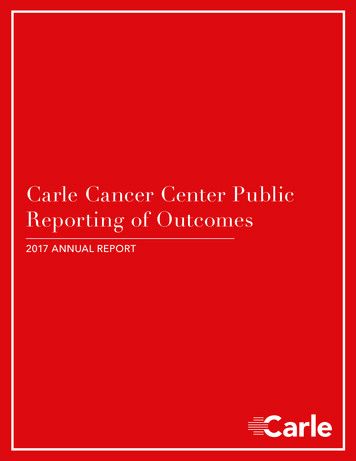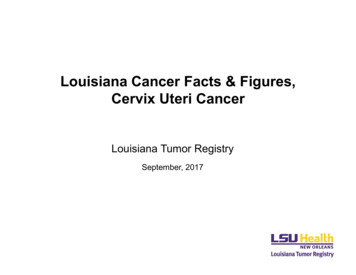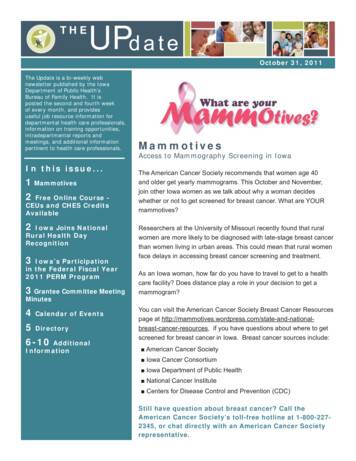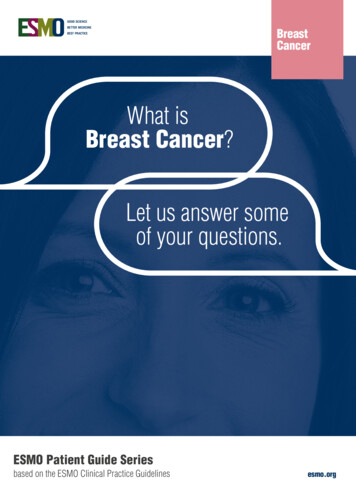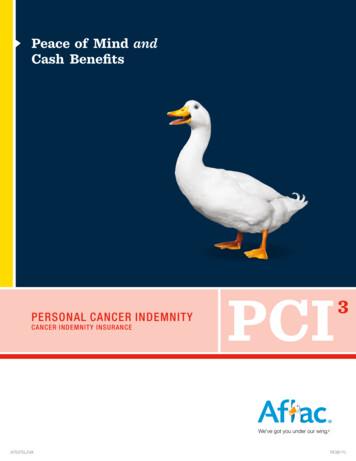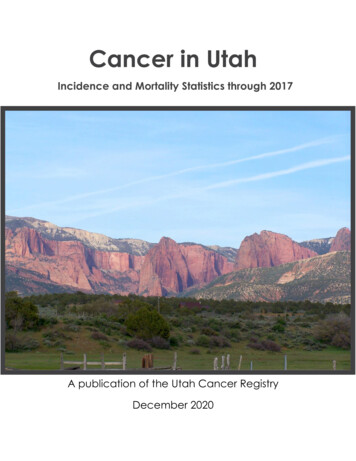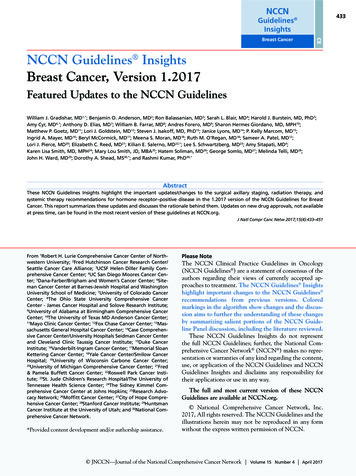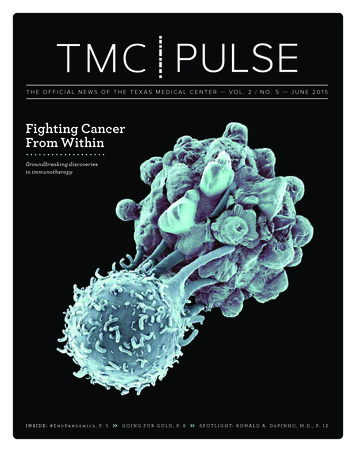
Transcription
THE OFFICIAL NEWS OF THE TEXAS MEDICAL CENTER — VOL. 2 / NO. 5 — JUNE 2015Fighting CancerFrom WithinGroundbreaking discoveriesin immunotherapyI N S I D E : # E n d P a n d e m i c s , P. 5»G O I N G F O R G O L D , P. 8»S P O T L I G H T : R O N A L D A . D e P I N H O , M . D . , P. 1 2
LILLIAN TERRACEVISTAS DE SEVILLAHERMANN PARK COURTRICE MILITARYRICE MILITARYMEDICAL CENTERFROM THE 640’SFROM THE 440’S 439,990HEIGHTS PLACEWINSOME PARK1418 GOLIADHEIGHTSGALLERIASAWYER HEIGHTSFROM THE 440’SFROM THE 690’S 514,000CIT Y1206 WILLARDEMERALDS AT DORRINGTONWEST U COURTMONTROSEUNIVERSITY PLACEWEST UNIVERSITY PLACE 1,229,000FROM THE 730’SFROM THE 670’S713-868-72265023 Washington Avenuewww.UrbanLiving.comwww.urban Inc, TREC Broker #476135NMLS: 137773
TMC PULSE//TABLE of CONTENTS5#EndPandemics.Global leaders convene in Houston todiscuss issues surrounding prevention,preparedness and response regardingglobal infectious diseases.june 201581216Going for GoldSpotlight:Ronald A. DePinho, M.D.Fighting Cancer From Within.Twelve-year-old Adrianna, diagnosedwith congenital glaucoma as an infant,hopes to inspire others as she somersaults toward her Olympic dreams.The president of The University ofTexas MD Anderson Cancer Centerdiscusses how his institution is passionately fighting to eliminate cancer.Cancer immunotherapy, engaging apatient’s own immune system in thefight against cancer, is quickly becoming one of the most promising frontiersof cancer treatment.24Star for a Day.For the second consecutive year,Ronald McDonald House Houstonteamed up with Magnolia Hotels toprovide residents and their familiesa much-needed day of leisure.30Closing the Gap in Fetal Surgery.Physicians at Texas Children’s FetalCenter and Baylor College of Medicinesuccessfully completed a new minimally invasive repair technique to treatspina bifida in-utero.36Accolades.38MEDICAL WORLD AMERICAS // p. 22THE ANNUAL MEDICAL WORLD AMERICAS CONFERENCE BRINGS TOGETHERA DIVERSE SET OF HEALTH CARE PROFESSIONALS TO DISCUSS CORE ISSUESAND EXPLORE WAYS TO TRANSFORM THE FIELD FOR A BETTER FUTURE.[Short Takes.40Calendar]on the cover: A computer-generatedillustration showing one of the immunesystem’s attack cells, known as T-cells, forcinga cancer cell into programmed cell death.tmc» pu l se j u ne 2 0 1 51
PRESIDENT’S PERSPECTIVETMC PULSEVol. 2 No. 5June 2015Robert C. Robbins, M.D.President and Chief Executive OfficerAmanda D. SteinEditorastein@texasmedicalcenter.orgShea ConnellyAssociate Editorsconnelly@texasmedicalcenter.orgAlex OrlandoStaff Writeraorlando@texasmedicalcenter.orgAlexandra BeckerStaff Writerabecker@texasmedicalcenter.orgL. Morgan FarrarROBERT C. ROBBINS, M.D.President andChief Executive Officer,Texas Medical Center2tmc» p u ls e ju n e 20 1 5The human body is incredibly complex. It is only fitting that we have an equallycomplex and ever-vigilant defense system to help maintain balance and preventdisease. The immune system is made up of a network of cells—T-cells, B-cells andNK cells—capable of identifying and targeting unhealthy and potentially dangerouscells, including, importantly, cancer cells.This system is not always perfect, as those who suffer from autoimmune diseases know. An overly active immune system can attack otherwise healthy cells,causing conditions like rheumatoid arthritis, lupus, Crohn’s disease and others. Theimmune system is also carefully monitored in those undergoing organ transplantation, as the system often attacks new tissue, potentially leading to the body’srejection of a transplanted organ.There are some researchers and physicians who argue that the immune systemis so important to human health, it warrants a national research program on thescale of the Human Genome Project. On a daily basis, our immune systems aremonitoring our bodies for cancerous cells, identifying and killing them.In this issue of TMC Pulse, you will read about the incredible work being doneat MD Anderson in the field of cancer immunotherapy—using a cancer patient’sown immune system to fight cancer cells. Dr. Jim Allison and his team are makingtremendous strides in their work with checkpoint inhibitors, which you will readmore about in this month’s cover story, “Fighting Cancer From Within.” Allisonhas dedicated decades to researching how the body’s T-cells can be “unleashed”to help specifically target and fight off cancer cells. It’s exciting and potentiallygame-changing work, and it is happening right here on this campus.Independently and collaboratively, researchers in the Texas Medical Centerand around the world continue to explore new ways to not only harness the immunesystem to fight off infection and disease, but to also bring balance to those sufferingfrom an overly or low functioning immune system.With these passionate and dedicated researchers committed to harnessing thebody’s own built-in defense system, there is no telling what the future may hold forthe treatment of cancer and other deadly diseases.Business StrategistContributing PhotographersScott DaltonNick de la icalcenter.orgTexas Medical Center Pulse is a monthlypublication of the Texas Medical Center,in Houston, Texas. Permission from theeditor is required to reprint any material.Editorial/advertising information availableon request.Texas Medical Center News is a member of:Houston Press Club,American Medical Writers Association,Association of Healthcare Journalists, andAmerican Advertising Federation
WE WANTTOHEARFROMYOUTAKE THE TMC NEWS READERSURVEY AT TMCNEWS.ORGEnter to win a free iPad! Tell us what you enjoy most about TMC Pulse, and what we can do to better serve our community.Visit TMCNews.org and click on “Reader Survey” to submit your feedback and be entered for achance to win a free iPad! Winner will be announced following the survey close on July 1, 2015.iPad is the registered trademark of Apple, Inc. Texas Medical Center is not associated with or sponsored by Apple, Inc.tmc» pu l se j u ne 2 0 1 53
Cardiovascularcare at UTMB.It’s about gettingyour life back.John has always enjoyed fishing with the guys anddancing with his wife. After having coronary bypasssurgery at age 42, he got back to his life. But this year,17 years later, he knew something wasn’t right.Tests confirmed John’s suspicions. Because he’dalready had a bypass, the only option appeared to begetting on a heart pump and waiting for a transplant.Then the cardiovascular team at UTMB Health tookanother look and saw another way. They recommendedan aggressive bypass graft procedure. It was a highrisk procedure given John’s history, but it offered agreater chance of getting his full life back. And hetrusted the UTMB team.John benefited from a team of skilled specialists,subspecialists, surgeons, nurses, and technicians.These gifted clinicians teach others their art, using thelatest equipment, technology and techniques. TodayJohn is back on his boat and before long he’ll be backdoing the cha-cha.Cardiovascular care at UTMB is comprehensive andstate of the art, from heart rhythm studies to bypass totransplants to cardiac rehab. We’re also close by, whichmakes visiting easy and appointments convenient.And we’re accessible 24/7 through our nurse-staffedAccess Center.If your heart is holding you back, do what John did.Take charge of your health and call us at800-917-8906, or go to utmbhealth.com towork wonders for you.Left: Emmanuel Amulraj, MDMinimally Invasive Cardiac Surgery, Heart and Lung TransplantationCenter Left: Michael Silva, Jr., MD, FACSChief, Division of Vascular Surgery and Endovascular TherapyCenter Right: Shreyas Modi, MD, FACCDirector, Heart Station, Cardiac Rehabilitation, Inpatient Services and CCURight: George Carayannopoulos, MDDirector, Heart Rhythm CenterThe four clinicians featured here are representative of the whole team of specialists spanning ourcardiovascular services.The University of Texas Medical BranchMember, Texas Medical Center4tmc» p u ls e ju n e 20 1 5
#EndPandemicsTexas A&M Health Science Center hosts the 6th George H.W. Bush China-U.S. Relations Conferenceto promote collaboration and cooperation in the fight against global infectious diseasesBy Alexandra BeckerOIt would be wonderful if one of the collaborations between theU.S. and China would be to help strengthen, identify and supportnational public institutions like CDCs in countries in Africa and Asiaand all over the world, because they provide the sustainable basis forkeeping people safe.n the morning of May 12, the pitch-perfect voicesof the Texas A&M University Singing Cadetsfilled the Phantom Ballroom at Houston’s Hotel ZaZawith the sound of the National Anthem of the People’sRepublic of China. The serenade was immediatelyfollowed by the Star-Spangled Banner, thus formallycommencing the opening ceremony for the 6th GeorgeH.W. Bush China-U.S. Relations Conference, which tookplace at the hotel over the course of three days.Hosted by Texas A&M Health Science Center(TAMHSC) and Chinese People’s Association forFriendship with Foreign Countries, and co-hosted byPeking University Health Science Center, Texas A&MUniversity, and the Texas Medical Center, the conference was attended by an elite group of representativesthat included physicians, researchers, policymakers,government officials and leaders in the public, privateand academic sectors from China and the U.S.The formal symposium, which was first held in2003 under the leadership of President George H.W.Bush, works to advance his vision and legacy of establishing better understanding, closer ties and collaboration between the two countries. By concentratingon issues surrounding prevention, preparedness andresponse regarding global infectious diseases, thisyear’s event marked the first time the traditionallybroader diplomatic meeting focused on one specific,actionable topic.“Microbes respect no national boundaries, nopolitical affiliations and no ethnicities,” said BrettGiroir, M.D., chief executive officer of TAMHSC, whoserved as moderator for the conference. “Given today’sglobal connectivity, an epidemic anywhere will rapidlybecome a threat everywhere.”That threat—be it Ebola, MERS, SARS, drugresistant tuberculosis, bioterrorism, pandemic influenza, or a host of lesser known microbes and viruses—served as the springboard for the keynote addresses,plenary panels and roundtable discussions that tookplace over the course of the gathering. Ultimately, thegoal was to not only create potential solutions andstrategies for moving forward, but to also establishnew networks for ongoing collaboration betweenindustry leaders in the U.S. and China.— THOMAS FRIEDEN, M.D.Director of the U.S. Centers for Disease Control and Preventiontmc» pu l se j u ne 2 0 1 55
From left to right, conference co-chair Neil Bush, keynote speaker Thomas Frieden, M.D., director of the U.S. Centers forDisease Control and Prevention, and Brett Giroir, M.D., chief executive officer of Texas A&M Health Science Center.Sometimes, curing andpreventing infectious diseasesmeans more about economicdevelopment than it does aspecific vaccine. There cannever be global economicdevelopment until we releasethe poorest 1.5 billion peopleon the planet from the traps ofpoverty and illness.— BRETT GIROIR, M.D.Chief Executive Officer ofTexas A&M Health Science Center6tmc» p u ls e ju n e 20 1 5“The point of this conference is to develop a sustainable, close tie between the two most powerfuland influential countries on earth so that we can actmore efficiently and effectively in preventing andresponding to an outbreak of infectious disease,” saidNeil Bush, son of George H.W. Bush and a co-chairof the conference.Robert C. Robbins, M.D., president and CEO ofthe Texas Medical Center, added, “While the conference provides many opportunities for collaborationand cooperation between clinicians, scientists andeducators around important issues such as emerging pathogens and emergency preparedness, it alsopromotes discussion on other topics critical to healthcare today, including cancer genomics and cardiovascular diseases.”The event was co-chaired by Bush and Madame LiXiaolin, president of the Chinese People’s Associationfor Friendship with Foreign Countries, and featuredseveral of the world’s most renowned scientists andpolicymakers. Participants were encouraged to sharetheir experiences on social media using the hashtag#endpandemics to increase awareness of the issuesdiscussed, and both Chinese and English translationservices were available at all sessions.The dialogue addressed many facets of the issueat large, including vaccine development, policyguidelines, ethics, research advancement, the roleof commercialization and corporate programs inpromoting global health security, insights from thefront line of the Ebola outbreak, and more. Roundtablesymposia provided the opportunity for attendeesto convene and review the critical role of researchcollaboration between China and the United States.Each roundtable encompassed multiple sessions,giving participants time to outline an agenda forfuture collaboration in science and policy for thetopics addressed, which ranged from new tuberculosis diagnostics to mobile health technology to naturalremedies and products.One of the predominant themes of the conference was the importance of assisting less developedcountries in the global fight to promote health for thepoorest populations.During a plenary session focused on publichealth preparedness in the developing world, andhow China and the U.S. could provide leadership,Nils Daulaire, M.D., senior visiting scholar on GlobalHealth Security at the Norwegian Institute of PublicHealth and U.S. Representative to the Executive Boardof the World Health Organization, discussed the policy roles of the two countries in developing ongoingand robust programs at home while assisting lessdeveloped countries as a whole—and not just whena pandemic strikes.“The bottom line is that we’re in this together,”he said. “We’re talking a lot about pandemics andglobal infectious diseases, but we also recognize thatthe emerging health issues in the least developedcountries is this overlap of two great sets of issues.One is what I call the unfinished agenda—maternaland child health, infectious diseases, the spread ofanti-microbial resistance—and that is an area thatrequires ongoing attention, assistance and work, buton top of that, we now have emerging, throughout theworld, the non-communicable diseases catastrophe.”
Classified under this umbrella are the explodingrates of cancer, heart diseases, chronic lung diseaseand diabetes.“We recognize that while we call them non-communicable diseases, they are, in fact, communicable. I callthem socio-communicable diseases, because they arespread from society to society, often from rich westernsocieties to some of the poorer societies,” Daulaireexplained. “The drivers there are not just the healthinterventions, but what we call the social and economicdeterminants of health. Trade policy is relevant, economic development priorities, the ways in which food isprocessed and distributed and used—all of these thingsneed to be a part of our common dialogue between thetwo strongest economies in the world in order to helpprotect those that are less fortunate than we are.”Peter Hotez, M.D., Ph.D., who serves as U.S. ScienceEnvoy (North Africa and Middle East), dean of theNational School of Tropical Medicine at BaylorCollege of Medicine, professor of pediatrics andmolecular & virology and microbiology and head ofthe Section of Pediatric Tropical Medicine at BaylorCollege of Medicine, Texas Children’s HospitalEndowed Chair of Tropical Pediatrics, and director of the Sabin Vaccine Institute Texas Children’sHospital Center for Vaccine Development, expandedon Daulaire’s remarks and stressed the importance ofaddressing poverty in the context of global health.“If you look at poor people across the planet, everysingle poor person living in poverty has at least oneneglected tropical disease,” Hotez explained. “We allknow about Ebola, but the rest are what I call the mostimportant diseases you’ve never heard of. They occurin the setting of poverty and they also cause poverty.Many of these neglected tropical diseases and chronically debilitating infections actually shave IQ pointsoff children. We’ve shown that hookworm actuallyreduces your future wages by 40 percent, that many ofthese diseases make individuals too sick to go to work,or they affect the health of girls and women—the point isthat every single person living in poverty has them, andthese are the stealth diseases that trap the bottom 1.5 billion people in the world in this vicious cycle of poverty.”Giroir echoed these sentiments in a later session.“Sometimes, curing and preventing infectious diseasesmeans more about economic development than it doesa specific vaccine,” he said. “There can never be globaleconomic development until we release the poorestFIRST HELD IN 2003 UNDER THE LEADERSHIP OF PRESIDENTGEORGE H.W. BUSH, THE INTERNATIONAL CONFERENCE WORKS TOADVANCE HIS VISION AND LEGACY OF ESTABLISHING BETTERUNDERSTANDING, CLOSER TIES, AND COLLABORATION BETWEENTHE U.S. AND CHINA.1.5 billion people on the planet from the traps of poverty and illness.”Thomas Frieden, M.D., director of the U.S. Centersfor Disease Control and Prevention (CDC), whodelivered one of the keynote addresses, focused onthe Ebola outbreak in West Africa and the importanceof early intervention and preparedness in the future,including an increased focus on biosafety and security,immunization, surveillance of zoonotic diseases inhumans and the growing threat of antimicrobialresistance. By utilizing surveillance technology,lab-work and enhanced information systems, andincreasing disease detectives and other public healthstaff throughout the world, Frieden explained thatnations could respond more rapidly and effectivelyto the emerging and ongoing public health crises. Heencouraged conference attendees to commit resourcesto field epidemiology training programs and nationalpublic health institutes throughout the world.“It would be wonderful if one of the collaborations between the U.S. and China would be to helpstrengthen, identify and support national public institutions like CDCs in countries in Africa and Asia andall over the world, because they provide the sustainable basis for keeping people safe,” Frieden said.That the prestigious international conference wasset in Houston, in the middle of the Texas MedicalCenter, was no coincidence. For one, TAMHSC ishome to the Texas A&M Center for Innovation inAdvanced Development and Manufacturing (CIADM),one of only three centers in the country established asa public-private partnership with the U.S. Departmentof Health and Human Services to help ensure thedevelopment and production of lifesaving vaccinesand therapies in the event of a pandemic or othernational emergency. Even more, Houston is famouslydriven by innovation in medicine, and it is only fittingthat some of the world’s most celebrated scientists andpolicymakers would convene here to collaborate onsuch pressing issues.“We are known as an oil and gas capital, and thatis still very much a part of who we are as a city andwhat fuels our economy,” said Mayor Annise Parkerduring the opening ceremony. “But the single biggest destination for foreign visitors to Houston is theTexas Medical Center—as doctors, as researchers, aspatients, as thought leaders—and in our examinationof what we are as a city, we’ve discovered some things:oil is what drives our economy, space is what fuels ourimaginations—because we are the home of NASA andthe astronaut corps—but medicine is our future.”Political and scientific leaders from the U.S. and Chinaspeak at the opening reception program for the 6thGeorge H.W. Bush China-U.S. Relations Conference.tmc» pu l se j u ne 2 0 1 57
8tmc» p u ls e ju n e 20 1 5
Going for GoldShe’s a 12-year-old Olympic hopeful—oh, and she’s legally blindBy Alexandra BeckerAdrianna salutes the judges’ tableand mounts the balance beam.She pauses briefly to raise both handsbefore beginning a series of judiciouslyrehearsed cartwheels and handstands,executing each until she hears thepunctuated thump of a perfect landing.Amid cheers, her gaze shifts once moreto the judges’ table and she smiles,though she can barely make out theirfaces. Diagnosed with congenitalglaucoma as an infant, Adrianna, whois now 12 years old, is legally blind.“We could tell something waswrong really early on,” recalled AshaKenebrew, Adrianna’s mother. “She wasso sensitive to light. Her eyes wouldwater a lot, and she was very uncomfortable whenever we took her outside.When I voiced these concerns to herpediatrician, I remember she checkedher eyes three different times and thentold us to go straight over to TexasChildren’s Hospital, that there was apediatric ophthalmologist waiting forus there. They determined that nightthat she had glaucoma.”A rare disease of the eye affectingchildren at birth, congenital glaucomais characterized by abnormally highintraocular pressure, or pressure withinthe eye. The disease originates from animbalance in the mechanisms responsible for circulation; in a healthy eye, fluidflows in and out through a network ofcells and tissues, but with glaucoma, thefluid does not drain properly, causingpressure to accumulate. The buildupof pressure often causes permanentdamage to the optic nerve, resulting invarying degrees of vision impairment.Symptoms of the disease includephotophobia, or light sensitivity, excessive tearing, and involuntary closure ofthe eyelids, known as blepharospasm.If diagnosed and treated early, congenital glaucoma does not always lead tovision impairment, and many pediatricpatients will not experience lastingsymptoms. If suspected, parents shouldcontact their pediatrician immediatelyso any pressure inside the eye can berelieved as soon as possible.Despite detecting her glaucomaat just four months old, Adrianna’sdisease has been aggressive anddifficult to treat. As an infant, sheunderwent multiple surgeries torelieve the intraocular pressure and hassince completed numerous additionalprocedures including shunt implantsand various incisions designed to drainthe excess fluid from her eyes. She hassubsequently developed cataracts, hadan additional surgery as a result, andfollows extensive maintenance andtreatment guidelines including theuse of three different eye drops, twicea day. Just this past October, afteran unexpected further deteriorationin her sight, she underwent a laserprocedure to help suppress her eyes’fluid production.“She’s responded very well to thislast surgery and her vision is definitelybetter than before, but there was along healing time associated with it,”said Kenebrew. “The crazy thing is,Adrianna, who was diagnosed with congenital glaucoma as an infant, practices gymnasticsat the Texas Academy of Acrobatics and Gymnastics.throughout all of this, she hasn’t let anything get in the way of her gymnastics.After the laser procedure, she was usingdilating drops for a month, but evenwith her eyes dilated she still competedand went to her state qualifier meet.”Of course, Adrianna’s persistencewas no surprise to her parents. At justfour years old, she already knew shewanted to be a gymnast after watchingcompetitions on television. She beggedher mother for lessons, and a few shortyears later found herself in her very firstgymnastics class at the Texas Academyof Acrobatics and Gymnastics.She’s an inspiration. Everyone has deficits, and it doesn’t matter whatthey are, you just have to learn to work with the things you have been given,and she’s done a great job of that.— KIMBERLY G. YEN, M.D.Pediatric Ophthalmologist at Texas Children’s Hospital and Associate Professor of Ophthalmology and Pediatrics atBaylor College of Medicinetmc» pu l se j u ne 2 0 1 59
The crazy thing is, throughout all of this, she hasn’t let anythingget in the way of her gymnastics.— ASHA KENEBREWAdrianna’s Mother“She really wanted a balance beamand she wanted to do the uneven bars,and we’ve never really said, ‘You know,I don’t think you’re going to be ableto do that because you can’t see,’” saidKenebrew. “We haven’t done anythingspecial, we just never held her back.We didn’t want there to be any regrets,where we wished we would have let hertry something.”Originally, Kenebrew never plannedon enrolling her daughter in competitions, but Adrianna showed a precocious interest in the sport and hasconsistently surprised both her parentsand coaches with her capabilities.“Every time she gets to a new level,her coaches say, ‘How is she going todo that? How will she see to jump tothe high bar?’ But she just does it,”said Kenebrew.No one is more impressed than herphysicians, who grasp both the clinicaland practical challenges the ambitious12-year-old—who wears customizedglasses and uses a special magnifyingmachine to help her at school—faces.“Glaucoma narrows the visual field,so in addition to being extremely nearsighted, she has poor peripheral vision,”explained Kimberly G. Yen, M.D.,Adrianna’s pediatric ophthalmologistat Texas Children’s Hospital andassociate professor of ophthalmologyand pediatrics at Baylor College ofMedicine. “She can only make out thelarge ‘E’ on the top of the eye chart andmaybe one or two additional lettersunder that, in one eye. Most peoplethink of gymnasts as having very goodvision so they can land on the balancebeam and grab the bars, and certainlyyou would think that peripheral visionis important as well. I think it’s incredible that she’s been able to compensateand, despite her visual disability, be acompetitive gymnast.”10tmc» p u ls e ju n e 20 1 5In typical Adrianna fashion,overcoming these colossal obstaclesto be a competitive gymnast is notenough—she’s planning to be a greatone. In 2013, Adrianna was awardedthe Texas Amateur Athletic Federation(TAAF) Female Athlete of the Yearfor her region in recognition of herwork ethic, personality, teamwork andskill. She competed in the TAAF StateMeet in May and will train with USAGymnastics in the fall. Ultimately,she hopes to earn a spot on TeamUSA, traveling with an elite group toa dazzling new stadium in matchingred, white and blue, to compete in theSummer Olympics.“She wants to be the first visuallyimpaired gymnast to win gold at theOlympics,” said Kenebrew. “This hasbeen her answer and she came up withthis all on her own. She doesn’t just sayshe wants to go to the Olympics. Shewants to win gold at the Olympics.”After coming this far, it’s not difficult to imagine Adrianna on television,with millions of young girls watchingher expertly executed routines, someof them turning to their parents and,despite their own obstacles, beggingfor lessons.“Just keep trying no matter howhard it is,” said Adrianna, when askedwhat advice she might give to otherswith similar ambitions. “You can alwaysreach your dreams, no matter what theyare and no matter how hard they areto reach.”She’s living proof, after all.“She’s an inspiration,” said Yen.“Everyone has deficits, and it doesn’tmatter what they are, you just have tolearn to work with the things you havebeen given, and she’s done a great jobof that.”
Looking for pediatric CME?We don’t kid around.Now you can choose the timeand place to take the coursesyou need and want. Available and FREEto any physician Online, 24/7 access Short, time-saving tutorials Developed by the TexasDepartment of StateHealth Services and theTexas Health and HumanServices CommissionMore than 50 CME courses approvedby 10 accrediting bodies include: Children with Diabetes Children with Asthma Management of Overweightand Obesity in Childrenand Adolescents Medical Home Newborn Screening Pediatric Depression Injury PreventionEthics CME available forthese courses: Teen Consent and Confidentiality Culturally Effective Health Care Recognizing, Reporting,and Preventing Child Abuse Motivational Interviewing Transition Services for Childrenand Youth with SpecialHealth-Care Needs Introduction to Screening,Brief Intervention, and Referralto Treatment (SBIRT): Tutorialtxhealthsteps.comAccredited by the Texas Medical Association, American Nurses Credentialing Center,National Commission for Health Education Credentialing, Texas State Board of Social WorkerExaminers, Accreditation Council of Pharmacy Education, UTHSCSA Dental School Officeof Continuing Dental Education, Texas Academy of Nutrition and Dietetics, Texas Academy ofAudiology, and International Board of Lactation Consultant Examiners. Continuing Educationfor multiple disciplines will be provided for these events.tmcSTEPS 0652 TMCNEWS 9n5x12n5 JUNE v3.indd 1» pu l se j u ne 2 0 1 54/23/15 1:11 PM11
TMC SPOTLIGHTRONALD A. DePINHO, M.D., PRESIDENT OF THE UNIVERSITY OF TEXAS MD ANDERSON CANCER CENTER, SAT DOWNWITH TEXAS MEDICAL CENTER EXECUTIVE VICE PRESIDENT AND CHIEF STRATEGY AND OPERATING OFFICERWILLIAM F. McKEON TO LOOK BACK ON THE INFLUENCES THAT LED HIM TO MEDICINE, AND HOW PASSIONAND DEDICATION DRIVE THE MD ANDERSON TEAM IN THEIR BATTLE AGAINST CANCER.Q Tell us a bit about your upbringingand the influences that shapedyour life.A We’re all shaped by our past in aprofound and enduring way. We are theproduct of our culture, our family corevalues and our educational experienceprovided by devoted mentors. There arereally three major forces that shaped mylife and my current position.The first one, of course, is my family.My mother and father came from avery poor background in Portugal, withlimited opportunity. My dad, at age17,
Alex Orlando Staff Writer aorlando@texasmedicalcenter.org Alexandra Becker Staff Writer abecker@texasmedicalcenter.org L. Morgan Farrar Business Strategist Contributing Photographers Scott Dalton Nick de la Torre NEWSROOM 713-791-8812 news@texasmedicalcenter.org ADVERTISING 713-791-8894 newsads@texasmedicalcenter.org DISTRIBUTION 713-791-6130




